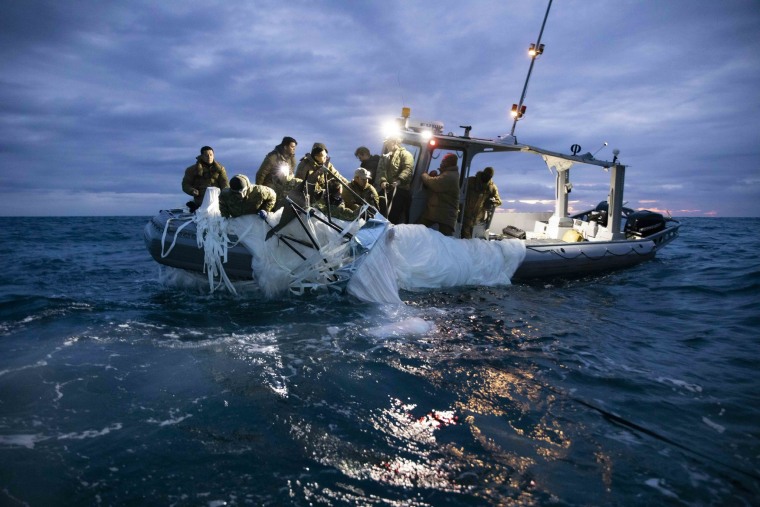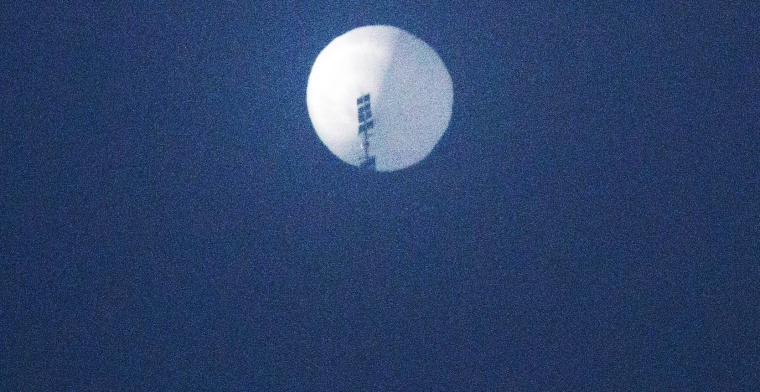The scale of China’s balloon surveillance could be more extensive than a handful of flights over the U.S., as intelligence agencies sift through hundreds of sightings of unidentified balloons and aerial objects in recent years, a lawmaker, a U.S. official and experts told NBC News.
The Biden administration is still trying to determine the full extent of China’s spy balloon intrusions into U.S. airspace, and it’s possible that the number of confirmed Chinese surveillance flights over the U.S. rises.
The revelation this month that the Chinese were able to fly surveillance balloons into American airspace without the U.S. military detecting it over a period of years has raised questions about an intelligence failure and prompted calls for investments in the country’s air defense and radar systems.
There are currently five known Chinese balloon flights into U.S. territory, including two during the Biden administration and three during Donald Trump’s presidency, according to the Biden administration’s public statement. The military and intelligence agencies detected the three balloon flights during the Trump presidency after Trump had left office, by reviewing the data for previous sightings of unidentified aerial objects, according to Biden officials. The four known flights prior to the February shootdown spent far less time in U.S. airspace.
The U.S. military and intelligence agencies are examining previous sightings of unidentified objects over the U.S. using new information gleaned from tracking the Chinese balloon that flew across the country earlier this month, the U.S. official and lawmaker said. That balloon, which was 200-feet tall and carried a payload weighing more than 2,000 pounds, was shot down on Feb. 4 off the coast of South Carolina by a missile fired from a F-22 fighter jet.
“I think now that we really understand a lot more about these things, we’ll be in a position to better understand what they’ve done in the past,” said Rep. Jim Himes of Connecticut, the ranking Democrat on the House Intelligence Committee.
The congressman said he expected more Chinese balloon flights to be identified.
“It is likely,” he told NBC News. “I do think that now, having watched one of these balloons, for more than a week, we know a lot more about how they behave and what they’re capable of. So yes, I do believe that we’ll be able to sort of backfill.”
The White House National Security Council did not respond to a request for comment. The Pentagon declined to comment.
Other countries are also examining whether Chinese balloon flights over their territory went undetected.
Japan’s ministry of defense said on Tuesday that it carried out further analysis and determined that three unidentified flying objects were “strongly presumed” to be Chinese reconnaissance balloons that violated the country’s airspace.
The flights took place in November 2019, June 2020 and September 2021, Japan said in a statement.
British Defense Secretary Ben Wallace said his government will review the country’s security in light of the Chinese balloon flight over the U.S.
Australia was not aware of any Chinese surveillance balloons flying over its territory, an Australian official said. But China has carried out a “relentless campaign of espionage” against Australia on many fronts and “Australia is watching this very closely,” the official said.
The U.S. Defense Department received 366 new reports of UFOs or “unidentified aerial phenomena” since March 2021, and about half of them appeared to be balloons or drones, according to a report from the Office of the Director of National Intelligence released last month.
An initial assessment found that 163 sightings were balloons or “balloon-like entities,” the report said.
It remains unclear if new information could indicate that those balloon sightings were in fact Chinese surveillance airships.
Sen. Marco Rubio of Florida, the ranking Republican on the Senate Intelligence Committee, told reporters “there’s been things flying over places that don’t belong in America for a very long time.”
He added that was why lawmakers had pushed for setting up an effort to study sightings of unidentified aerial objects.
The full scale of China’s intrusions into U.S. airspace remain unclear, and arriving at a precise number for how many balloon flights took place may not be feasible, according to Brynn Tannehill, a technical analyst at the Rand Corp., a think tank.
“The answer is we don’t know. And I think we’re going to work very hard to find out and I think we’re going to go back and look at a lot of data to try and come up with some kind of estimate,” said Tannehil, a former U.S. Navy pilot who flew P-3 surveillance aircraft. “Because even when we go back and review the data, we can assume that there’s stuff that we did not see.”
The Pentagon and White House officials have rejected the idea that undetected Chinese balloon flights in recent years over U.S. territory represented a possible intelligence failure.
Pentagon press secretary Brig. Gen. Pat Ryder told a news conference last week that “in terms of monitoring these and collecting on them, we have been able to put together a body of knowledge that enables us to be able to detect them and act.”
“It was not an intelligence failure,” Ryder said.
But lawmakers are demanding more information from the White House about the Chinese surveillance balloon program and how the U.S. has responded to it.

The president needs to “clarify what the heck is going on” and “what intelligence gaps” need to be addressed, Republican Sen. Todd Young of Indiana said on Fox News on Wednesday.
In his most extensive public remarks about the Chinese balloon and three unidentified objects that were shot down by U.S. fighter jets this month, President Joe Biden said on Thursday he expected to speak with China’s President Xi Jinping and later told NBC News that he didn’t think the Chinese leader wanted to damage relations with the U.S.
Intelligence officials on Wednesday briefed former Trump administration national security officials on China’s surveillance balloon program, NBC News reported earlier. The briefing touched on China’s overall program, as well as past incidents of surveillance balloons’ entering U.S. airspace, including during the Trump and Biden administrations.
The government clearly “missed the Chinese high-altitude balloon threat for a long time,” said one congressional staffer. U.S. officials weren't "looking for them and were surprised when they finally discovered them,” the staffer said.
“There needs to be further scrutiny on past intrusions. Additionally, those incidents should have prepared the U.S. government for the more recent and more serious incursion,” the staffer said.
The head of U.S. Northern Command and the North American Aerospace Defense Command, Air Force Gen. Glen VanHerck, said earlier this month that the Chinese balloon flight had highlighted a “domain awareness gap.”
Michael Dumont, a retired Navy admiral who was deputy commander of U.S. Northern Command from October 2018 to February 2021, said it’s too early to tell how damaging the Chinese balloon surveillance program has been, and that officials will know more after the balloon’s recovered sensors are analyzed.
But if nothing else, “the balloon program allows them to test out things, see how we react.”
Former senior military officers and experts say the balloon incident has also spotlighted long-standing weaknesses in the Cold War-era system of radars that is supposed to detect threats to the North American continent.
The U.S. and Canadian militaries rely on a chain of radar sites across northern Canada to track the northern approaches to North American airspace. The North Warning System (NWS) uses short- and long-range radar sites constructed in the late 1980s and the radars are becoming “increasingly challenged” by modern weapons technology, according to the Canadian government.
In 2021, VanHerck said that a more advanced system was needed for the NWS that could detect not only bombers or cruise missiles but small drones.
“The system itself, the guts of the system, was developed in the 1980s,” Dumont, the former deputy commander at Northern Command, said recently in an interview.
The outdated technology means analysts at Northern Command must rely on separate systems to detect different sorts of threats, he said.
“When you think about the ability to integrate all kinds of sensors into a warning system, we’re just not there,” Dumont said. “We don’t have a central consolidated point to integrate these systems into one … The guts of the system need to be upgraded.”
A more modern system, he said, could give the U.S. “much greater standoff range and much greater early warning.”
In the current system, when analysts adjust the “gain” of the radars to detect slow-moving objects like surveillance balloons, their screens fill up with various objects, most of which are irrelevant.
“There were times I was on duty that I would get alerted to a certain activity and it turned out to be a flock of birds or debris from a weather balloon,” he said.

